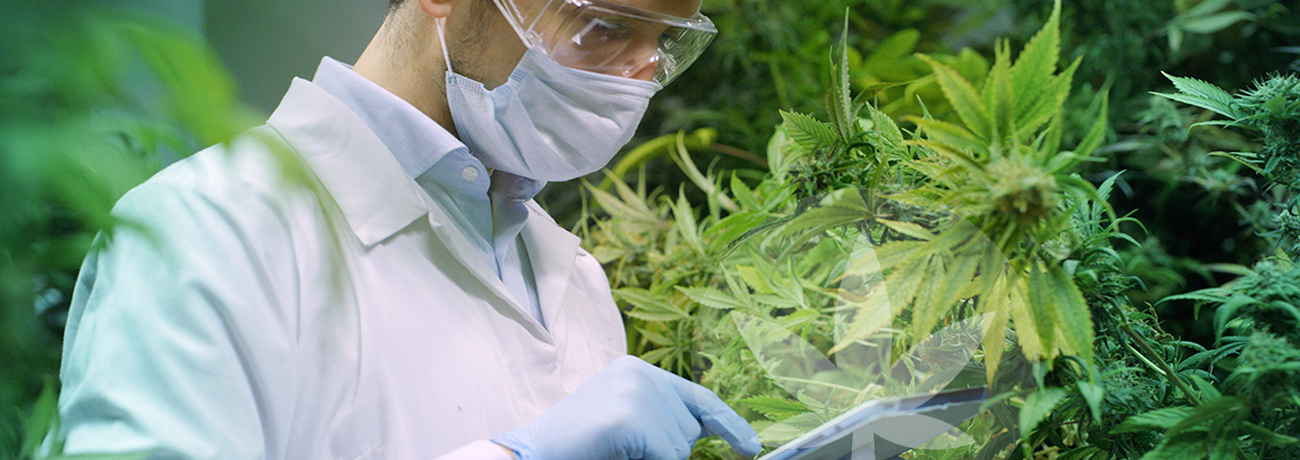What Does Science Say About CBDV?
Last updated:
Published:
What is cannabidivarin (CBDV)?

With a very similar name, the natural assumption may be that CBDV is the same as its cannabinoid twin, CBD. For the most part, this assumption would be correct. At a molecular level, the chemical structure of CBDV resembles that of CBD. However, if we take a few steps back through the biosynthesis pathways (the reactions that create different cannabinoids), we can start to identify some of the principle distinctions exhibited by CBDV.
We need to take roughly two steps back from CBDV to understand a bit more about how it is created. One of the founding cannabinoids, CBGVA, reacts to the presence of the CBDA enzyme to become CBDVA. Although close, we still need to remove the acid compounds to create a more concentrated and stable cannabinoid. Once we apply heat to CBDVA, we end up at the compound in question, CBDV. Despite the fact that it has taken scientists a while to decipher how CBDV is created, the cannabinoid has caught the eye of the pharmaceutical world.
What makes CBDV different?
The primary reason for the interest in cannabidivarin stems from how it interacts with the body. The two most prominent cannabinoids, CBD and THC, both invoke a reaction because of the way they stimulate our endocannabinoid system (ECS). Specifically, they bind to/antagonise CB1 and CB2 receptors found throughout the body, which are linked to the ECS. CBDV is unique because it does not prompt a reaction from either type of CB receptor. Instead, the secret to CBDV’s therapeutic potential comes from the way it can activate or desensitise our transient receptor potential channels (TRP channels).
What are TRP channels?
A more straightforward way to visualise TRP channels is to think of them as gauges on a car. If your body is the car, then the different parts of the engine are your cells. Our TRP channels act as gauges designed to monitor various sensations within plasma cells. Just like a car, if the TRP channels swing to the extreme ends of the indicator, problems can occur. A car would break down if the temperature gauge reached excessive temperatures, or start to run poorly if the pressure gauge was fluctuating. Similar rules apply to TRP channels, as the cells use them to decide what action to take when they experience sensations like pain, temperature, and pressure.
Don’t let the complicated title of these channels put you off. They play a very important, behind the scenes role. Without them, the human body would not be able to measure several sensations accurately. TRP channels are also categorised into families depending on which plasma cells they exist within. You may be wondering what TRP channels have to do with the cannabinoid CBDV; well, remember how the channels mediate sensations within cells?
The link between TRP channels and epilepsy
One specific family of TRP channel (TRPV1) is linked to the onset of several types of epilepsy. When the TRPV1 gauge becomes overexcited, it causes too many signals to be sent to cells, an example of a mechanism of action. The hyperexcitability of these specific channels contributes to epileptic activity and seizures. This is where CBDV steps in. Preliminary studies have shown that measured doses of CBDV can desensitise the TRPV1 channels, thus exhibiting anti-epileptic activity. CBDV can calm the channels, restoring balance and preventing triggering a bombardment of signals.
With TRP channels found throughout the body, their mediation is proving to be of vital importance. Restoring balance, or homeostasis, is a natural process for the human body. Balanced biological systems can prevent the onset of numerous damaging conditions. In the case of TRP channels, mutations have been linked to neurodegenerative disorders. This makes the role of CBDV research paramount, as the cannabinoid may have a further beneficial impact throughout the body.
The link between CBDV and 2-AG
The second prominent attribute of CBDV is its ability to affect the production of 2-arachidonoylglycerol (2-AG), one of our body’s endocannabinoids. It is also a characteristic that further separates it from the capabilities of CBD. By preventing the creation of the diacylglycerol lipase enzyme, the body is unable to synthesise 2-AG as it usually would. While the clinical implications of CBDV’s ability to inhibit 2-AG are not known, doing so does not prevent CBDV from carrying out its anti-epileptic duties.
Improving the absorption of cannabinoids
All of these potential uses for CBDV sound fantastic, but there is one fly in the ointment. CDBV has very low water solubility, which means it is not readily absorbed by the body and is often destroyed by digestive enzymes before it can take effect. If you take CBDV orally, typically less than 6% is transferred into your bloodstream. This presents a significant challenge for pharmaceutical enterprises. The actual efficacy of CBDV could be lacking not because of its own abilities, but because the body cannot properly absorb it.
Fortunately, there is a solution to this problem, arriving in the form of liposomes. These are tiny spherical protectors made up of phospholipids. These phospholipids work in layers to deliver pharmaceutical drugs in a more concentrated dose. By placing an active compound inside a liposome, that chemical is protected as it is processed by the body’s digestive enzymes. In the case of CDBV, the low-water solubility can be negated by shielding the compound within liposomes. The same approach can also be applied to other cannabinoids, thus improving both their potency (bioavailability) and efficiency.
The future of CBDV
At present, what we know about CBDV is very limited. However, what we have discovered could prove crucially important in treating several conditions. Thankfully, this is an outlook that pharmaceutical companies share, as the cannabinoid is rapidly gaining traction in academic circles. With more research on the horizon, it should only be a matter of time before we begin to understand the true capability of CBDV.











